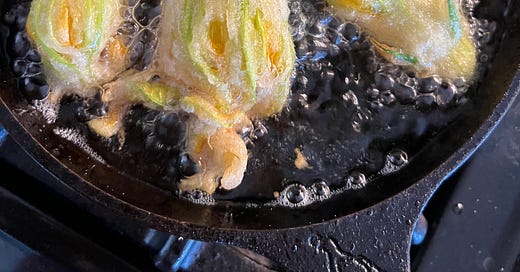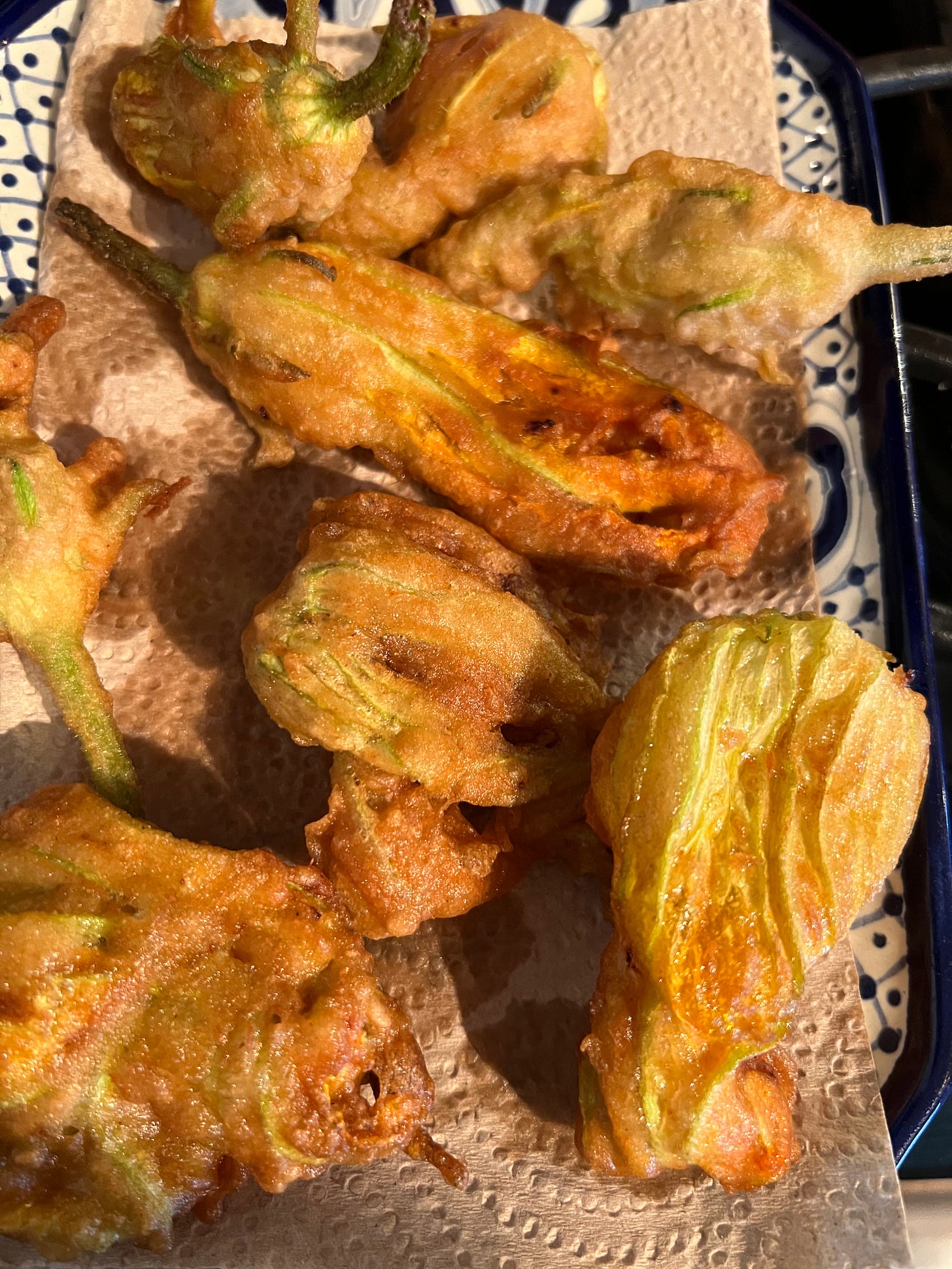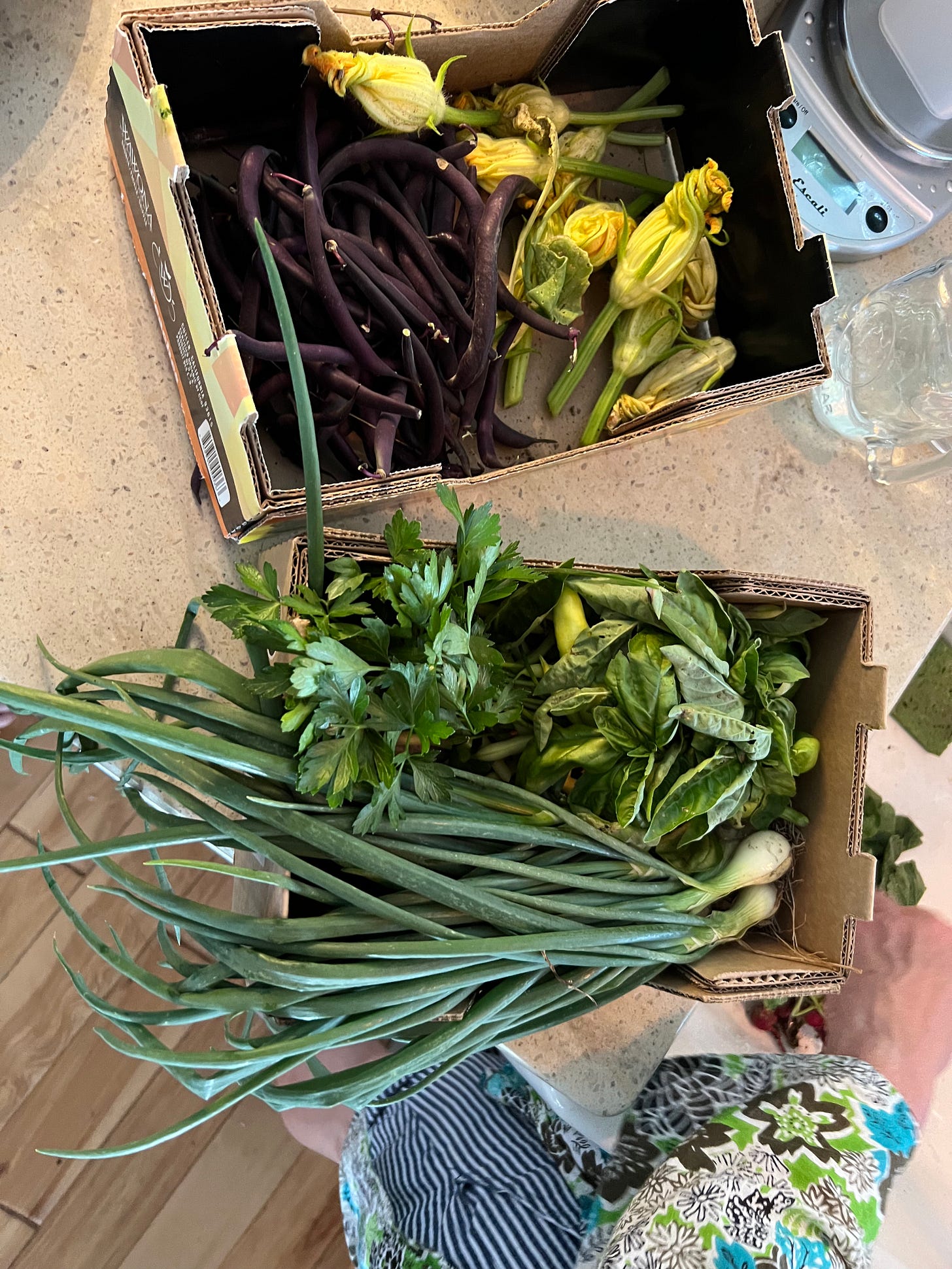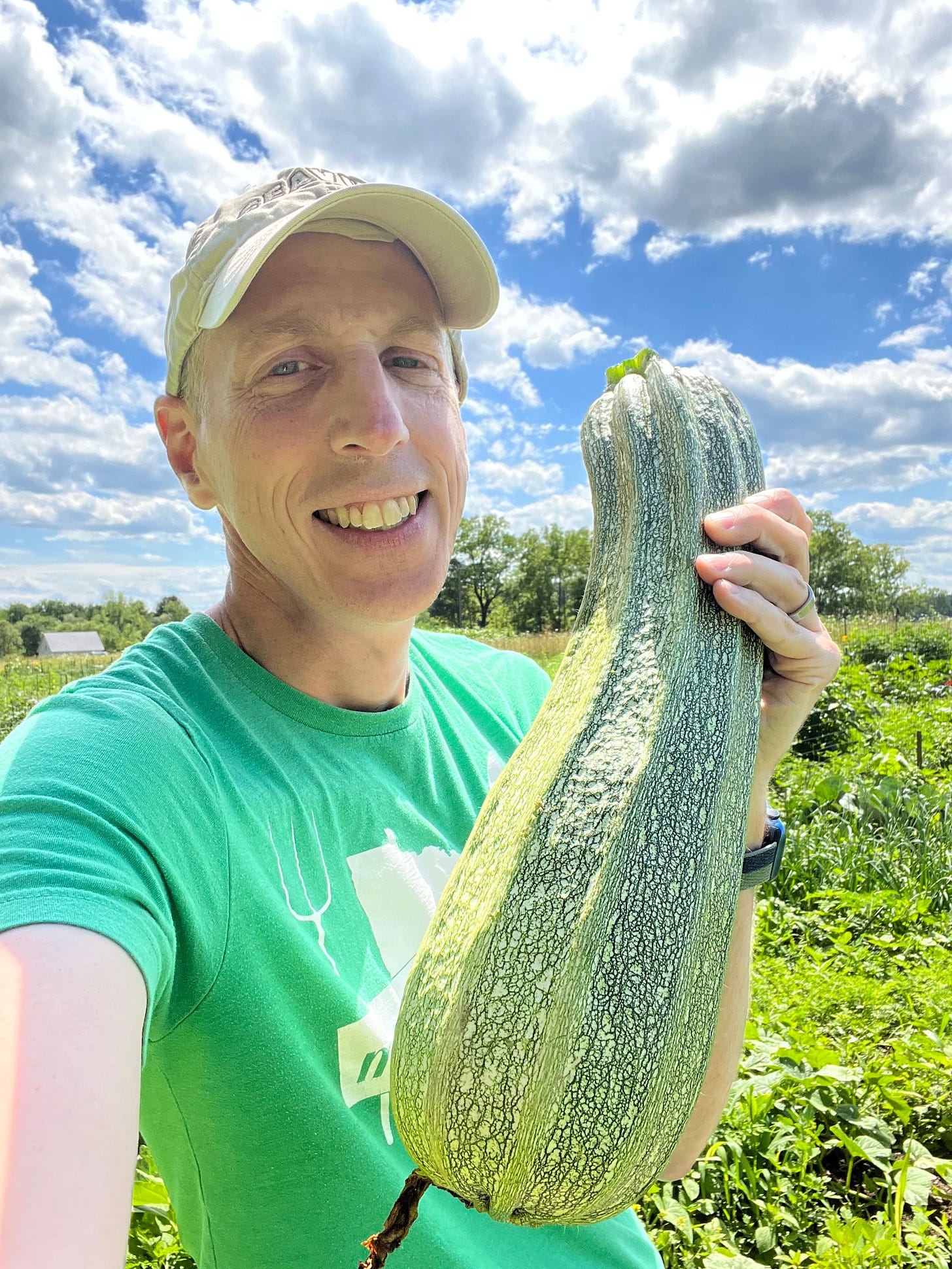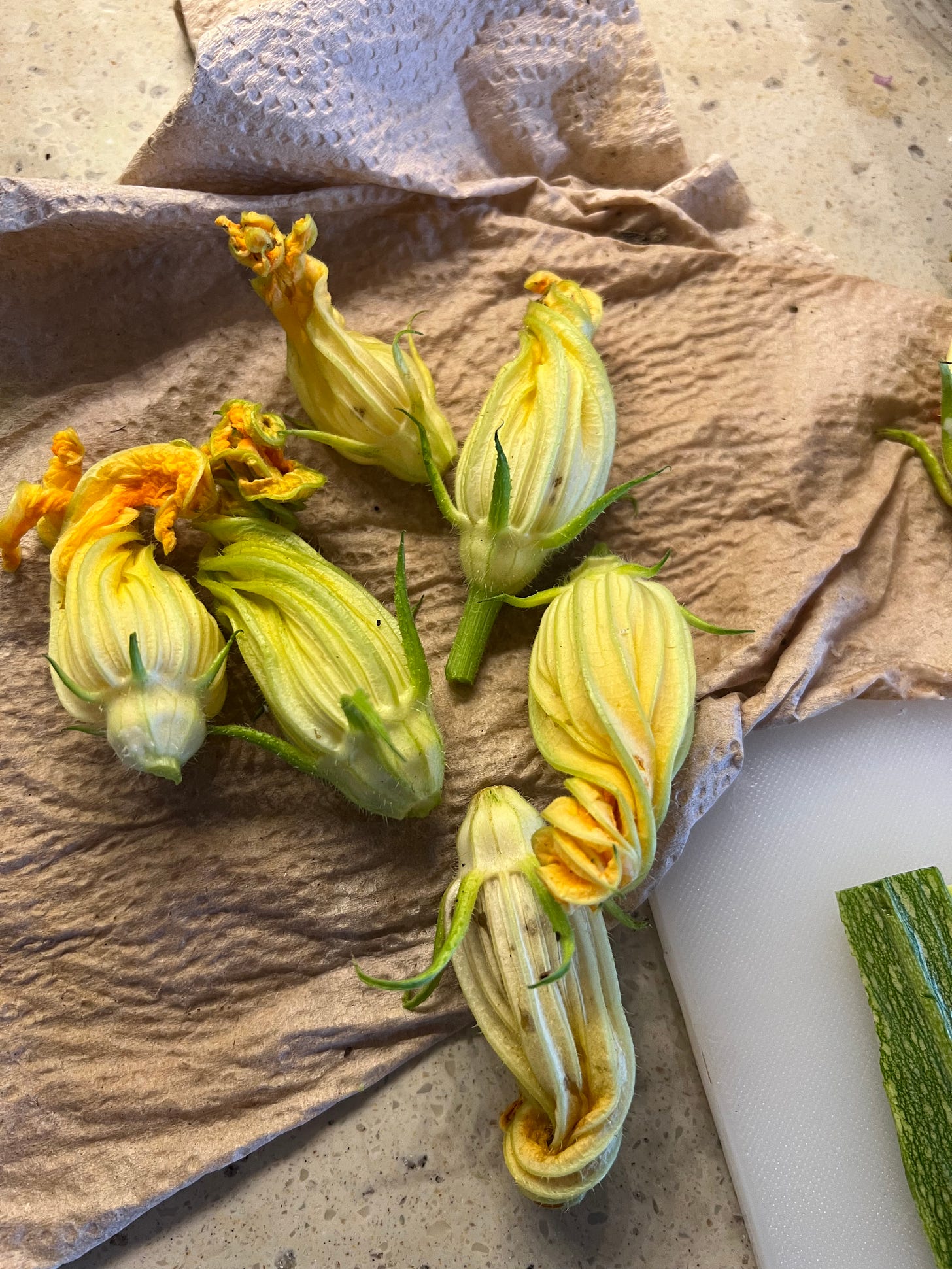Issue #62: Flower Power
Fried Squash Blossoms, Don't Be Daunted by Deep-Frying, Crying Zucchini "Uncle"
I just keep cooking and cooking. Can’t seem to stop. Each week, when I look back at photos of what I’ve made, it’s hard to decide what to write about. The produce this time of year doesn’t need much help. I just coax it into something presentable. This week I thought I would suggest you make something that seems a bit of a challenge, but is really quite easy, something that always impresses people, And as an added bonus, helps save the world from even more zucchini than we already know what to do with. I hope you enjoy it. And if you do, please encourage friends and family to sign up. Thank you. —Mitchell
Squash blossom always draw my attention. In general, the idea of eating flowers makes me happy: I love flowers; I love eating. Putting the two together seems very Garden of Eden to me. (I resisted writing Garden of Eatin’ just then, but couldn’t resist long enough to avoid it in this parenthetical comment.) Squash blossoms straddle the line between flower and vegetable. Sometimes, if you are lucky, you find a squash with its blossom still attached. That’s a good day to buy a lottery ticket.
I imagine my fondness for fiori di zucca developed during the time I’ve spent in Italy, where they are common and used in a variety of ways. You see them stuffed—with anchovy, mozzarella, ricotta, or a combination—and/or fried, or in pasta, on focaccia, in frittate. One of my favorite pizzas at Gabrielle Bonci’s Pizzarium in Rome was topped with thin slices of zucchini and blossoms.
Apizza Aside: My husband Nate is fond of telling the story of our first trip to Rome together, just a few months after we met. He should have considered himself warned. I was dragging him to Pizzarium, at that time, a relatively unknown sliver of a shop in a quiet residential area. To get there, you pretty much had to walk around or through the Vatican. “Aren’t we going to stop to see the Sistine Chapel?” Nate asked incredulously, trying to keep up with my pace. “I’ve already seen it,” I replied. He could have noted that I’d already had the pizza al taglio at Pizzarium, too, but instead we agreed to visit the Vatican after lunch.
Since we’ve been tending a friend’s garden up in the Finger Lakes, I have a new appreciation for eating zucchini flowers: doing so prevents more zucchini from growing. I know it is a cliché, but we are inundated with zucchini. Some are larger than Nate’s head. The miracle of their rapid growth from week to week doesn’t diminish the feeling of being overwhelmed I have while I try not to waste any of this prolific summer squash. Luckily, our friends planted the Romanesco variety of zucchini, whose ridged flesh is dense, meaty and flavorful, even when grown to gargantuan proportions. I’ve been grilling zucchini, sautéing zucchini, frying it in olive oil for pasta alla Nerano, scrambling it with eggs, dicing it for fried rice, Parmesaning it with tomato sauce and cheese. I haven’t started baking it into breads and muffins yet, though surely they’re coming soon.
But back to the blossoms.
Simply fried squash blossoms are a frequent hors d’oeuvre in our home. Yet, this is the first time I’ve culled them myself, dunking them in batter and dropping them into hot oil within hours of picking. Ordinarily, I would be daunted by deep frying, the amount of hot oil required seemingly both wasteful and dangerous. But my approach of late is to use a small cast-iron pan with just about an inch of oil. I make a quick, light batter with some flour and any flavorful liquid I have lying around. I dip the blossoms in quickly—as for tempura, don’t worry if they are unevenly coated—before frying them crisp. A sprinkling of salt and fried zucchini blossoms become the perfect accompaniment to a Negroni or a glass of Prosecco.*
To Prepare the Blossoms
I like to leave about an inch of the stem attached, if there’s any stem at all, and I keep the spikey fronds at the base of the flower intact, which I know others recommend removing; I think they are pretty when they are fried. I don’t remove any of the guts from inside the blossom, either, though you will want to take a peek to make sure there are no bugs trapped (or don’t, if don’t mind a little extra protein). Be careful not to rip off the petals if you can avoid it. If your blossoms are all curled up or they’ve fallen off the base, don’t worry. Dip what you’ve got in the batter anyway and reassemble it into a scraggly pile when you drop it in the oil. It will fry up perfectly delicious.
To Prepare the Batter
I keep this as simple as can be. An equal amount of all-purpose flour (gluten-free flour substitutes work fine, too) and liquid is all you need. Oh, and a pinch of salt. You can use water in a pinch, but I like to vary the liquid to add flavor. I use beer, white wine, vegetable stock, kombu dashi, buttermilk, sour milk, or anything, really. For extra umpf lately I’ve been adding a teaspoon of saikyo miso to the mixture, which contributes a jolt of umami. You really don’t need more. I don’t add egg because I don’t want the batter to be too thick and clingy. I want the look and taste of the flower to come through.
To dip, hold the stem or the base of the flower. Sweep the blossom through the batter and then drag it along the edge of the bowl as you remove it to scrape off any excess and plop it into the hot oil. I use a small cast-iron pan with about an inch of peanut oil heated to about 335°F. (It will get hotter as you work. Keep it below 360°F.) I can usually fit four or five blossoms in the pan at once. Let the flowers fry until nicely browned and crisp on the first side and then use tongs or a fork to flip them onto their second side. Sometimes trapped air balloons inside the blossom making flipping a challenge. Use your tongs or fork to hold the second side down in the oil until crisp. If you pierce the flower it will stay put, but be sure to drain any excess oil out when you remove it.
Remove the blossoms to a paper-towel-lined plate to drain while you dip and fry the rest. Sprinkle with a good salt and serve while still hot.
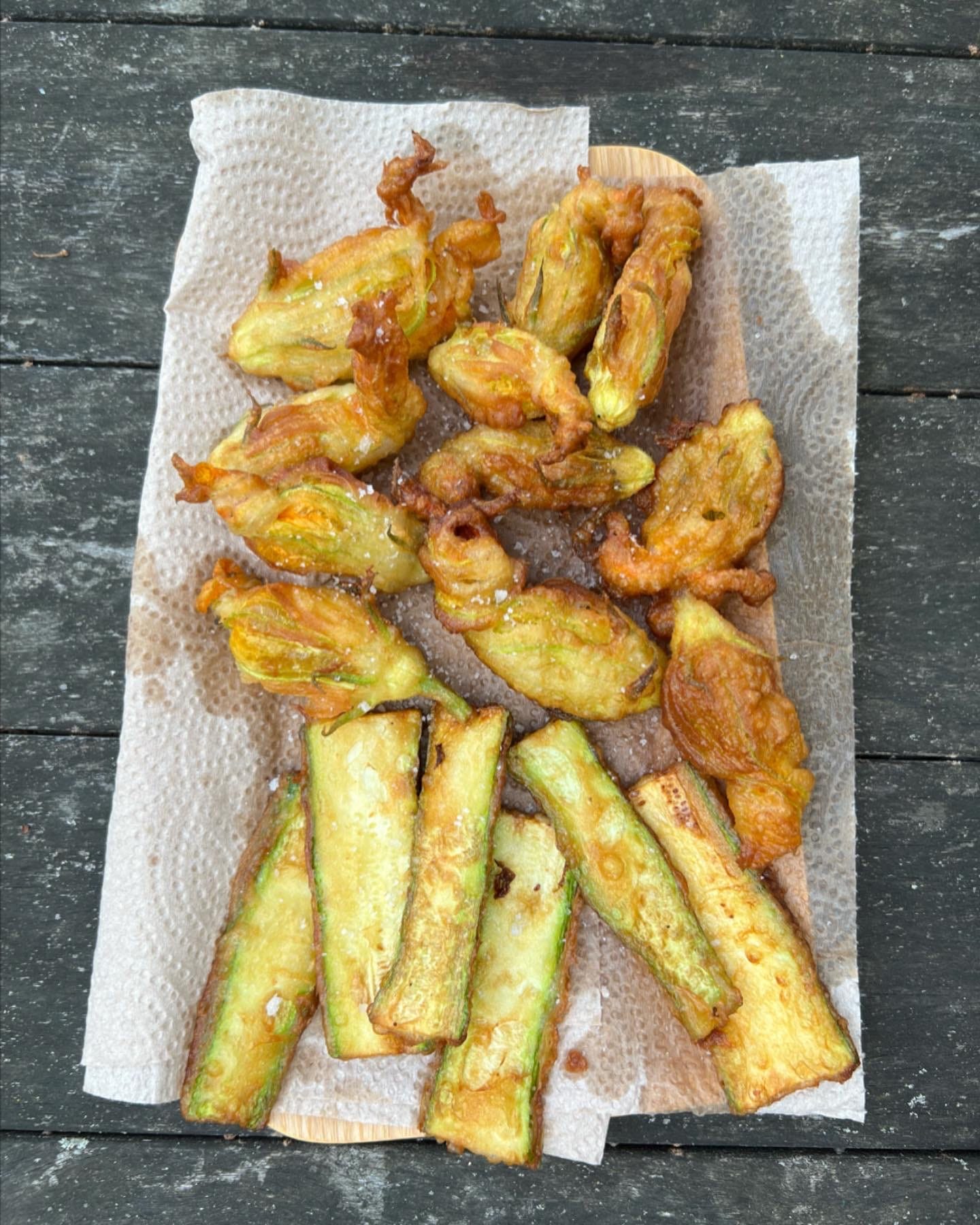
RECIPE: Fried Zucchini Blossoms
I don’t think you really need this recipe, but here you go.
(Makes 12 to 14 blossoms, depending on size. Enough to serve 1 to 4 people, depending on appetite.)
10 to 14 squash blossoms, trimmed as described above
1 to 1/2 cups peanut or other neutral vegetable oil, to get to a depth of 1 in a small frying pan
1/2 cup all-purpose flour or gluten-free substitute
1 heaping teaspoon saikyo miso (optional)
Pinch salt, plus additional for finishing
1/2 cup liquid, such as beer, white wine, vegetable stock, dash or kombu dash, buttermilk, sour milk, milk, or in a pinch, water
Peak inside the squash blossoms to see if any bugs are trapped. Do not rinse them. Heat about an inch of oil in a small, preferably cast-iron frying pan, over high heat until about 335°F. While it’s heating, in a small bowl, combine the flour, miso and salt. Add all but a couple of tablespoons of the liquid and using a fork or a small whisk, stir together to form a smooth batter, like a liquid pancake batter. Mix thoroughly, but don’t overmix. If you need more liquid, add it. Line a plate with paper towel.
When the oil is hot, pick up a squash blossom by the stem end and drag through the batter, moving it around to coat. Don’t worry if it isn’t perfectly coated. As you pull it out of the bowl, scrape it across the edge to remove excess batter. Place in the hot oil and repeat until you have 4 or 5 cooking. Turn down the heat to medium and cook until browned and crisp, 3 or 4 minutes. Use a fork or tongs to flip over and cook the other side. Lift out of the oil, drain, and place, separated, on the prepared plate. Repeat with the remaining blossoms until all are fried. Sprinkle with salt and serve with a Negroni or a glass of Prosecco.•
* This has nothing to do with anything, really, but the other day our friends Marion and Mal unexpectedly arrived at the lakehouse with some family and friends via sailboat, the name of which was Prosecco. You can listen to my interview with Marion on this week’s episode of my podcast What’s Burning, in which she explains the challenges of doing quality nutrition research and getting people to eat better.
